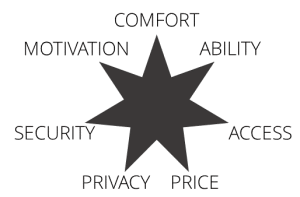Seven Principles for a world of technology for all
Bill Gates letter to Microsoft employees in commemoration of Microsoft’s 40th anniversary is brief, but it hints at what’s to come. If you look at the progression of technology in ten year blocks (2015, 2005, 1995, 1985, 1975) you get amazed by the decade-wide leaps we’ve made. Even the visionaries had a hard time describing what ten years in the future will look like, so 2025 is anyone’s guess.
That said, we are entering a new era in which technology is reaching a couple of extra billion people in the planet and it will make their lives significantly better. As we, technologists and entrepreneurs, build this future, we have to keep in mind a few things to make sure we are creating the “right” kind of future.
Here is a list of seven principles that we should live by as we build this future:
One — Comfort
We take it for granted the form-factors we have today without thinking how we got here. A keyboard and a mouse were clearly designed to help the office worker, not the field worker, the farmer, the factory worker or even doctors and nurses at a hospital. Laptops and tablets came to broaden the spectrum of the computing form-factor some people can use to do their job, but what’s next? We still have long ways to go in terms of voice-recognition, wrist-based computing (watches or something else), gesture recognition, and things that are just embedded in our clothes, walls, glasses, floors, etc. Physical burden should be a consideration in everything we build. We are not talking about early adopters anymore.
Two — Ability
We all faced a piece of technology that had a terrible UI or required us to acquire knowledge that wasn’t worth for the value it delivered, thus never crossing the chasm into the hands of most people. Delivering products that doesn’t create a cognitive burden for the user and works as seamlessly as turning a light switch is critical for its success. Doing less at the cost of functionality is probably a good place to start, but doing the right thing and deliver on the expectation is what we should be aiming for.
Three — Access
If people can’t acquire a product it will impossible for them to adopt it and benefit from it. If the tool is available, but the energy to power it doesn’t exist, it’s the same thing as not having this tool. If we build something that requires Internet connectivity all the time, we limit where this can be used.
Four — Price
No matter how great the technology is if the people that would benefit from it can’t afford, it’s of no use. The good thing is that in technology prices always goes down. Part is the advancement of manufacturing process, part is the commoditization of shared components, and part is higher demand that improves production effectiveness.
Five — Privacy
We came long ways in improving our understanding of technology privacy and human beings’ desire. Certainly some companies pushed the boundaries and felt pushed back. Privacy is not a one size fits all. The same way in a pre-technology era some people might feel comfortable talking about a rash in their legs or a fight they had with a spouse, others don’t. We must create technology that can be widely adopted. Unfortunately that means more work for us, the builders, to make sure we provide the right privacy controls and knobs so that all can feel unthreatened and welcomed as they are.
Six — Security
We are definitely entering a dark moment for security — and consequently privacy. This goes well beyond someone stealing a social security number. It goes into threats that people receive in social media and force them to abandon (or not even getting started with) a piece of technology that could be beneficial for them, professionally and personally. This is about basic safety and eliminating the fear of physical, emotional or reputation threats.
Seven — Motivation
Finally, people need to want to have the technology because they see a clear value personally or professionally by adopting it. It’s going to help than have more fun, reduce pain, make more money or save more money, achieve personal goals, etc. It boils down to helping people live longer and better lives.
2025 here we come.
